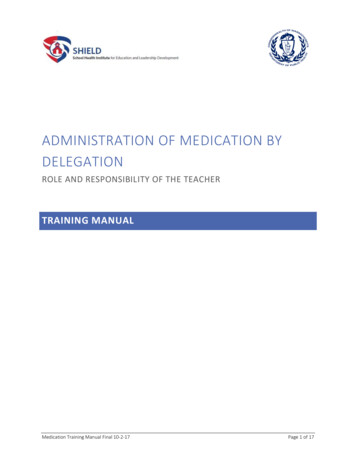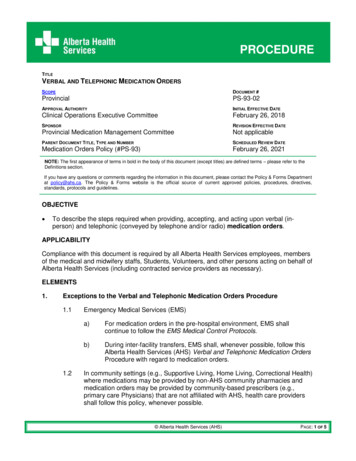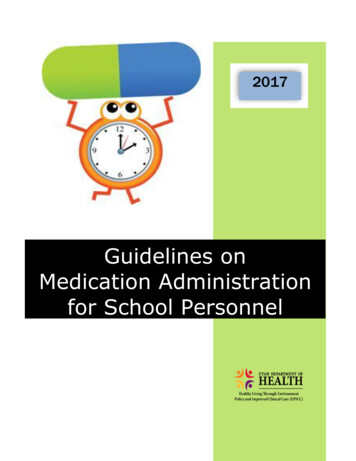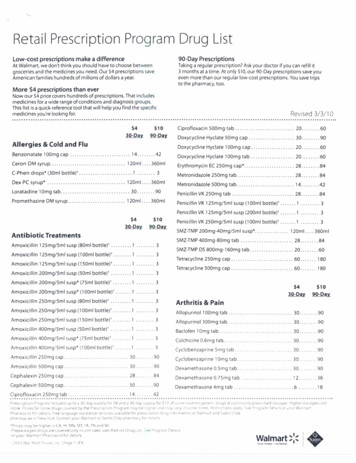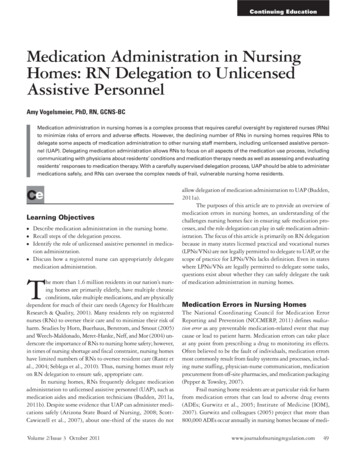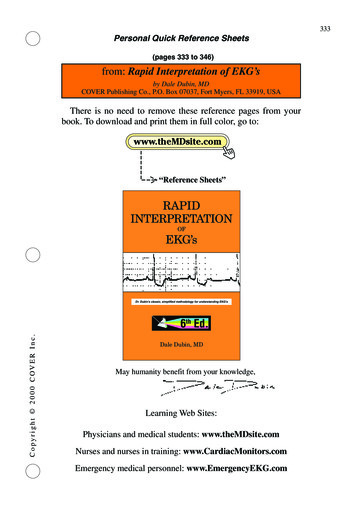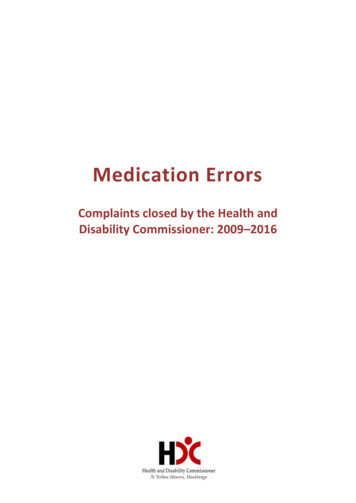
Transcription
Interpretation of PrescriptionsMedication OrdersDr. Esra Tariq BayrakdarReference text: -Pharmaceutical Calculation by Stoklosa; Latest edition.- Pharmaceutical calculations by Howar C. Ansel
Interpretation of Prescriptions and Medication OrdersCommon topics Demonstrate an understanding of the format and components of a typical prescription. Demonstrate an understanding of the format and components of a typical medication order. Interpret correctly standard abbreviations and symbols used on prescriptions and medication orders. Differentiate between patient compliance and noncompliance and apply calculations to determine compliancy.
Interpretation of Prescriptions and Medication OrdersDefinitionA prescription is an order for medication issued by a physician, dentist, or other properly licensed medical practitioner.Compounding: the quantities of active and inactive components to use in the extemporaneous preparation of apharmaceutical product, including the use of stock solutions and/or prefabricated dosage units in the process.Pharmacy compounding involves the mixing, assembling, packaging, and labeling of a medication on receipt of aprescription order for a specific patient and FDA permit the advance preparation of very limited quantities ofcompounded products.Chemical-physical factors including calculations to make solutions isotonic, iso-osmotic, equimolar, or buffered.Pharmacoeconomics: including medication costs, cost-benefit analysis, cost-effectiveness analysis, alternative treatmentplans, and medication pricing.
Interpretation of Prescriptions and Medication OrdersA prescription to be prepared by a pharmacist and administered to a particular patientComponents of a typical prescriptionParts labeled are as follows:(1) Prescriber information and signature(2) Patient information(3) Date prescription was written(4) symbol (the Superscription), meaning ‘‘take thou,’’‘‘you take,’’ or ‘‘recipe’’(5) Medication prescribed (the Inscription)(6) Dispensing instructions to the pharmacist (the Subscription)(7) Directions to the patient (the Signa)(8) Special instructions. It is important to note that for any Medicaidor Medicare prescription and according to individual state laws, ahandwritten language by the prescriber, such as ‘‘Brand necessary,’’may be required to disallow generic substitution.A prescription may include the chemical (generic) name of the substance or the trademark name(manufacturer’s brand)
Interpretation of Prescriptions and Medication OrdersMedication Orders include instructions are written by the physicianTypical hospital medication order sheet
Interpretation of Prescriptions and Medication OrdersMedication order for an infant, child, or an elderly person may also include the age, weight, and/orbody surface area (BSA) of the patientExample of a prescription for a pediatric
Interpretation of Prescriptions and Medication OrdersExample of a prescription written for a generic drugExample of a prescription requiring compounding
Interpretation of Prescriptions and Medication OrdersDrug-specific forms may be used, as for heparin dosing, electrolyte infusions, and morphine sulfate inpatient-controlled anesthesiaExample of a hospital form for prescribing a specificdrug treatment: Patient-Controlled Anesthesia
Interpretation of Prescriptions and Medication Orderse-prescriptions In the inpatient or outpatient setting, a medication order, for a patient is entered into an automateddata entry system as a personal computer (PC) or a handheld device loaded with e-prescribingsoftware and sent to a pharmacy as an e-prescription. When received, a pharmacist immediately reduces the order to a hard copy and/or stores it as acomputer file.
Interpretation of Prescriptions and Medication OrdersAdvantages cited for e-prescriptions over traditional paper prescriptions Reduced errors due to prescription legibility; Concurrent software screens for drug interactions; Reduced incidence of altered or forged prescriptions; Efficiency for both prescriber and pharmacist; and, Convenience to the patient, whose prescription would likely be ready for pick-up upon arrival at the pharmacy
Interpretation of Prescriptions and Medication OrdersPrescription and Medication Order AccuracyIt is the responsibility of the pharmacist to ensure that each prescription and medication orderreceived is correct in its form and content; is appropriate for the patient being treated; and issubsequently filled, labeled, dispensed, and administered accurately.In essence, each medication should be: Therapeutically appropriate for the patient; Prescribed at the correct dose; Dispensed in the correct strength and dosage form; Correctly labeled with complete instructions for the patient or caregiver; and For the patient in a hospital or other health care facility, each medication must be administered to thecorrect patient, at the correct time, and by the correct rate and route of administration.
Interpretation of Prescriptions and Medication OrdersRoman Numerals on PrescriptionsRoman numerals commonly are used in prescription writing to designate quantitiesLetters of fixed value used in the Roman system
Interpretation of Prescriptions and Medication OrdersCombining these letters are expressed as follows(1) Two or more letters express a quantity that is the sum of their valuesif they are successively equal or smaller in value:(2) Two or more letters express a quantity that is the sum of the values remainingafter the value of each smaller letter has been subtracted from that of a following greater:
Interpretation of Prescriptions and Medication OrdersSELECTED ABBREVIATIONS, ACRONYMS, AND SYMBOLSUSED IN PRESCRIPTIONS AND MEDICATION ORDERSa,b
Interpretation of Prescriptions and Medication Orders(continued)
Interpretation of Prescriptions and Medication OrdersThe correct interpretation of these abbreviations and prescription notations plays an importantpart in pharmaceutical calculations and thus in the accurate filling and dispensing of medication
Interpretation of Prescriptions and Medication Orders
Interpretation of Prescriptions and Medication Orders
Interpretation of Prescriptions and Medication OrdersMedication Scheduling and Patient ComplianceMedication scheduling may be defined as the frequency (i.e., times per day) and duration(i.e., length of treatment) of a drug’s prescribed or recommended use.Some medications, because of their physical, chemical, or biological characteristics or theirdosage formulations, may be taken just once daily for optimum benefit, whereas other drugproducts must be taken two, three, four, or more times daily for the desired effect.
Interpretation of Prescriptions and Medication OrdersPatient compliance with prescribed and nonprescribed medications is defined as patientunderstanding and adherence to the directions for use.The compliant patient follows the label directions for taking the medication properly and adheresto any special instructions provided by the prescriber and/or pharmacist.Some of the different types of problems relating to patient compliance with medication areexemplified by the following examples.
Interpretation of Prescriptions and Medication Orders
Interpretation of Prescriptions and Medication Orders
Interpretation of Prescriptions and Medication Orders
Interpretation of Prescriptions and Medication Orders
Interpretation of Prescriptions and Medication OrdersPatient noncompliance is the failure to comply with a practitioner’s or labeled direction in theself-administration of any medication.Noncompliance may involve underdosage or overdosage, inconsistent or sporadic dosing, incorrect durationof treatment, and drug abuse or misadventuring with medications.Patient noncompliance may result from a number of factors, including unclear or misunderstood directions, undesired side effects of the drug that discourage use, lack of patient confidence in the drug and/or prescriber, discontinued use because the patient feels better or worse, economic reasons based on the cost of the medication, absence of patient counseling and understanding of the need for and means of compliance, confusion over taking multiple medications, and other factors. frequently, patients forget whether they have taken their medications.
Interpretation of Prescriptions and Medication Orders
Interpretation of Prescriptions and Medication Orders
Interpretation of Prescriptions and Medication OrdersThanks
Interpretation of Prescriptions and Medication Orders Definition A prescription is an order for medication issued by a physician, dentist, or other properly licensed medical practitioner. Compounding: the quantities of active and inactive components to use in the extemporaneous preparation of a pharmaceutical product, including the use of stock solutions and/or prefabricated dosage units in .

